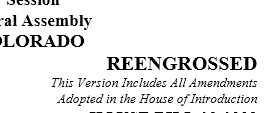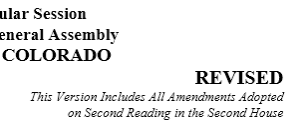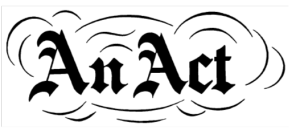By Ed DeCecco and Sharon Eubanks
A critical part of legislation that creates a new program or changes an existing one is the appropriation clause. Through this clause, the General Assembly exercises its plenary power of the purse and authorizes an agency to spend state money from an identified source for a particular purpose, usually for a limited time. Recently, the trend has been to include more details in the clauses, but their basic format has essentially been the same for over a century. During that time, the clauses have been interpreted and applied without much controversy.
Yet, after an internal review, the staff of the Office of Legislative Legal Services and the Joint Budget Committee believed that the appropriation clauses could be improved. The existing clauses, although functional, are difficult to understand. Specifically, the legislative staff thought the appropriation clauses should be rewritten to remove unnecessary language, which could be codified; to increase legal accuracy; and to improve readability. The changes, however, are not intended to affect the meaning of the appropriation clauses or how the State Controller allows a department to spend its money.
To ensure that the new format would not change the status quo, legislative staff vetted the clauses with the Executive Branch – the State Controller’s Office, the Office of State Planning and Budgeting, and all of the departments. Their feedback was very positive, and they did not identify any serious obstacles to adopting the proposed format, though legislative staff did incorporate several changes based on the departments’ suggestions. The legislative staff then presented the proposed new format for appropriation clauses to the Joint Budget Committee for approval. The Committee approved the use of the new format beginning with the 2015 legislative session.
Here is a typical, simple appropriation clause written in the new format:
SECTION _. Appropriation. For the 2015-16 state fiscal year, $73,972 is appropriated to the department of public health and environment for use by the prevention services division. This appropriation is from the general fund and is based on an assumption that the division will require an additional 0.9 FTE. To implement this act, the division may use this appropriation for the suicide prevention program.
Rather than writing the appropriation clause as a single, lengthy sentence as was previously the case, this new format for an appropriation clause employs a three sentence structure. The first sentence describes the fiscal  year, the amount of the appropriation, and the department, including the division that will use the appropriation. So, with a cursory review, a reader will know the essential information about the appropriation.
year, the amount of the appropriation, and the department, including the division that will use the appropriation. So, with a cursory review, a reader will know the essential information about the appropriation.
The second sentence identifies the source of the appropriation. If the source is a cash fund, the sentence will include the statutory citation for the fund, but that is unnecessary for the general fund. Also, rather than “appropriating” an FTE, it describes the associated FTE consistent with the definition of “FTE” in §24-75-112 (1) (d) (V), C.R.S., which applies to the Long Bill and complies with Colorado case law.
The third sentence specifically identifies how the department, or in this case the division, is permitted to use the appropriation. In many instances, this last sentence will include additional details about a program or a subdivision within the Long Bill so that the specified use corresponds to a Long Bill appropriation.
A key feature of the new format is what is excluded from the appropriation clause. Three phrases previously included in a clause – “In addition to any other appropriation”, “not otherwise appropriated”, and “or so much thereof as may be necessary” – are omitted from this new version. Instead these phrases are codified in Senate Bill 15-098, which the Governor signed into law on February 25, 2015. So the phrases will still apply to, but not clutter, each clause.
Legislative staff has created variations on this new standard format, including an appropriation clause that contains multiple purposes and a clause that directly syncs with an appropriation or series of appropriations made in the Long Bill. It is likely that a majority of appropriation clauses will be variations of the new three-sentence standard format or one of these other two clauses.
Without changing the meaning of appropriation clauses, legislative staff believes that appropriation clauses are now much easier to read. Hopefully you agree.






